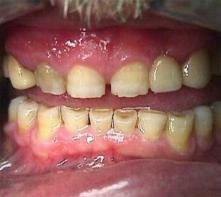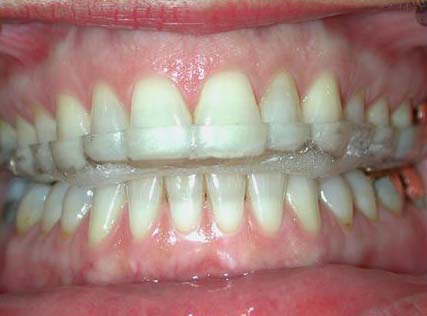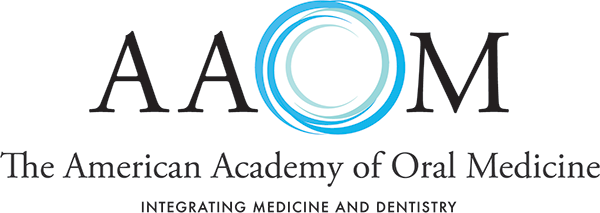Tooth Clenching or Grinding
Clenching or grinding of the teeth (bruxism) is a common activity that can occur both during the day and at night.
|
Clenching & Grinding
Some prefer to split these concepts into separate behaviors while others group them together. Grinding or bruxism involves moving the jaw with the teeth held together. This results in substantial visible wear and flattening of the teeth which is usually obvious both to dentist and patient. Clenching is simply holding the teeth together and tightening the jaw muscles. Clenching generally results in less obvious wear to the teeth but can still result in substantial muscular soreness, pain, and damage to the jaw joint.
|
Clenching or grinding (see Box to Right) while awake is especially common during periods of concentration, anger, or stress, and often occurs without a person being aware of it. Once a person is made aware of the habit, it can potentially be stopped or reduced by behavior modification, in some instances assisted by various forms of splint therapy. Bruxism during sleep is very different from bruxism while awake. Sleep bruxism is not under a person’s conscious control and usually occurs throughout the night during periods of arousal as a person goes from a deeper stage of sleep to a lighter stage of sleep. This pattern may be repeated many times during the night. Extreme forces can be generated by the jaws during clenching or grinding during sleep which can result in overuse of the jaw muscles - resulting in morning jaw pain or fatigue and jaw dysfunction. Sleep bruxism is not effectively treated by behavior modification or awareness and requires a different therapeutic approach. It also may be associated with a sleep disorder, such as obstructive sleep apnea.
 The prevalence of bruxism tends to decrease with age, with the highest prevalence during childhood and the lowest in people over 65. Many people clench or grind their teeth on occasion, however, only a small percentage of people do so with regularity and have problems as a result of it. Bruxism does not occur consistently but rather occurs episodically during certain periods or times of a person’s life. Most people who brux during sleep are not aware of it unless they are told that they grind their teeth by a parent or bed partner, or by their dentist who finds evidence of wear on their teeth. Signs or symptoms that may be suggestive of sleep bruxism include morning jaw pain, jaw fatigue or stiffness, clicking or popping of the jaw joints that is worse in the morning, significant tooth wear (see Right), and enlarged jaw muscles. Since bruxism occurs episodically over a person’s life, the presence of tooth wear does not necessarily mean that a person is currently bruxing. The prevalence of bruxism tends to decrease with age, with the highest prevalence during childhood and the lowest in people over 65. Many people clench or grind their teeth on occasion, however, only a small percentage of people do so with regularity and have problems as a result of it. Bruxism does not occur consistently but rather occurs episodically during certain periods or times of a person’s life. Most people who brux during sleep are not aware of it unless they are told that they grind their teeth by a parent or bed partner, or by their dentist who finds evidence of wear on their teeth. Signs or symptoms that may be suggestive of sleep bruxism include morning jaw pain, jaw fatigue or stiffness, clicking or popping of the jaw joints that is worse in the morning, significant tooth wear (see Right), and enlarged jaw muscles. Since bruxism occurs episodically over a person’s life, the presence of tooth wear does not necessarily mean that a person is currently bruxing.
Sleep bruxism can generally be diagnosed by a dentist after taking a history and performing a clinical examination. However, on occasion, an overnight sleep study performed by a physician may be required. The treatment of sleep bruxism usually includes the use of a bite guard or splint that is worn at night over either the upper or lower teeth. The main purpose of a bite guard is to reduce the wearing down of the teeth, but it also may provide symptomatic relief of jaw pain and dysfunction. The best type of bite guard seems to be one that is made of hard plastic and which covers all of the teeth in the arch. The short term use of medications such as a muscle relaxant may also be beneficial.
QUESTIONS AND ANSWERS ABOUT BRUXISM
Q: What causes sleep bruxism?
A: The exact cause of sleep bruxism is not known, however, it has been found to be associated with several factors such as daytime stress, anxiety, obstructive sleep apnea, loud snoring, heavy alcohol use, caffeine, smoking, and certain antidepressant drugs.. Recently, studies have shown that bruxing episodes during sleep are preceded by an increase of brain activity and heart rate. This suggests that central nervous system factors may play a important role in the initiation of bruxing. In the past, it was felt that a bad bite or a malocclusion was the cause of bruxism, however, numerous scientific studies have failed to show a relationship.
Q: How is sleep bruxism diagnosed?
A: The dentist can usually diagnose sleep bruxism by taking a thorough history and performing a clinical examination. A history of jaw discomfort or fatigue upon awakening in the morning along with a finding of excessive tooth wear or enlarged jaw muscles is very suggestive of sleep bruxism. In addition, frequently awakening with a headache in the morning may be due to bruxism. Generalized tooth sensitivity without any other explanation may be a symptom of sleep bruxism. If, in addition to sleep bruxism, a person also has symptoms of a sleep disorder such as a history of interrupted breathing during sleep or excessive daytime sleepiness, a physician specializing in sleep medicine should be consulted.
Q: How is bruxism treated?
 A: Daytime bruxism can usually be effectively treated by behavioral modification and habit reversal. This may be as simple as making the person aware of the habit and then placing visual cues around the home and work area to alert the person to check and be sure that their teeth are apart. For difficult cases, psychological counseling may be necessary. For sleep bruxism, a splint or bite guard worn at night is usually a cornerstone of treatment (see Right). In addition, medications may be used for short term control of the activity and may include muscle relaxants, tricyclic antidepressants, or antianxiety drugs such as the the benzodiazepines. Some other drugs are currently being investigated for treatment of the problem. Since a relationship between occlusion (or bite) and sleep bruxism has not been conclusively proven, adjustment of the bite by grinding the teeth or placement of crowns is not recommended. A: Daytime bruxism can usually be effectively treated by behavioral modification and habit reversal. This may be as simple as making the person aware of the habit and then placing visual cues around the home and work area to alert the person to check and be sure that their teeth are apart. For difficult cases, psychological counseling may be necessary. For sleep bruxism, a splint or bite guard worn at night is usually a cornerstone of treatment (see Right). In addition, medications may be used for short term control of the activity and may include muscle relaxants, tricyclic antidepressants, or antianxiety drugs such as the the benzodiazepines. Some other drugs are currently being investigated for treatment of the problem. Since a relationship between occlusion (or bite) and sleep bruxism has not been conclusively proven, adjustment of the bite by grinding the teeth or placement of crowns is not recommended.
Prepared by D Falace and the AAOM Web Writing Group
Prepared 15 October 2015
Japanese Translation - 日本語訳
Spanish Translation - Traducción Español
The information contained in this monograph is for educational purposes only. This information is not a substitute for professional medical advice, diagnosis, or treatment. If you have or suspect you may have a health concern, consult your professional health care provider. Reliance on any information provided in this monograph is solely at your own risk. |

 The prevalence of bruxism tends to decrease with age, with the highest prevalence during childhood and the lowest in people over 65. Many people clench or grind their teeth on occasion, however, only a small percentage of people do so with regularity and have problems as a result of it. Bruxism does not occur consistently but rather occurs episodically during certain periods or times of a person’s life. Most people who brux during sleep are not aware of it unless they are told that they grind their teeth by a parent or bed partner, or by their dentist who finds evidence of wear on their teeth. Signs or symptoms that may be suggestive of sleep bruxism include morning jaw pain, jaw fatigue or stiffness, clicking or popping of the jaw joints that is worse in the morning, significant tooth wear (see Right), and enlarged jaw muscles. Since bruxism occurs episodically over a person’s life, the presence of tooth wear does not necessarily mean that a person is currently bruxing.
The prevalence of bruxism tends to decrease with age, with the highest prevalence during childhood and the lowest in people over 65. Many people clench or grind their teeth on occasion, however, only a small percentage of people do so with regularity and have problems as a result of it. Bruxism does not occur consistently but rather occurs episodically during certain periods or times of a person’s life. Most people who brux during sleep are not aware of it unless they are told that they grind their teeth by a parent or bed partner, or by their dentist who finds evidence of wear on their teeth. Signs or symptoms that may be suggestive of sleep bruxism include morning jaw pain, jaw fatigue or stiffness, clicking or popping of the jaw joints that is worse in the morning, significant tooth wear (see Right), and enlarged jaw muscles. Since bruxism occurs episodically over a person’s life, the presence of tooth wear does not necessarily mean that a person is currently bruxing. A: Daytime bruxism can usually be effectively treated by behavioral modification and habit reversal. This may be as simple as making the person aware of the habit and then placing visual cues around the home and work area to alert the person to check and be sure that their teeth are apart. For difficult cases, psychological counseling may be necessary. For sleep bruxism, a splint or bite guard worn at night is usually a cornerstone of treatment (see Right). In addition, medications may be used for short term control of the activity and may include muscle relaxants, tricyclic antidepressants, or antianxiety drugs such as the the benzodiazepines. Some other drugs are currently being investigated for treatment of the problem. Since a relationship between occlusion (or bite) and sleep bruxism has not been conclusively proven, adjustment of the bite by grinding the teeth or placement of crowns is not recommended.
A: Daytime bruxism can usually be effectively treated by behavioral modification and habit reversal. This may be as simple as making the person aware of the habit and then placing visual cues around the home and work area to alert the person to check and be sure that their teeth are apart. For difficult cases, psychological counseling may be necessary. For sleep bruxism, a splint or bite guard worn at night is usually a cornerstone of treatment (see Right). In addition, medications may be used for short term control of the activity and may include muscle relaxants, tricyclic antidepressants, or antianxiety drugs such as the the benzodiazepines. Some other drugs are currently being investigated for treatment of the problem. Since a relationship between occlusion (or bite) and sleep bruxism has not been conclusively proven, adjustment of the bite by grinding the teeth or placement of crowns is not recommended.